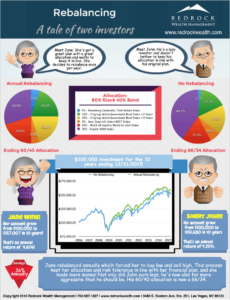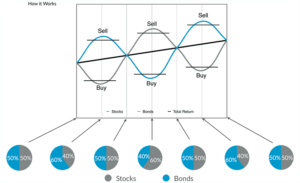
Investing for the future requires careful planning and consideration. You may be 30 and investing aggressively for growth. You may be 70 and focused on protecting your wealth. Either way, you need an investment plan!
You can’t have a great investment plan without putting in the work. Every quality investment plan is a function of:
- Risk capacity. How much risk can you withstand without major financial devastation. If we have another 2008 will your plan be completely derailed? Will you need to return to work or sell off other assets? Start by determining how much risk you can handle in stride.
- Risk required. How much risk do you need to take to achieve your financial and retirement goals? Some plans are so lofty they require a high rate of investment return. The higher the rate of return required the more risk you’ll need to expose your plan to. Other plans are very modest, and a low rate of return with lower levels of risk is more appropriate.
- Risk tolerance. How much volatility are you comfortable with? Do you sleep well at night when the market is down 2%? Are you OK with losing 10%, 20%, or more in a given year? Your risk tolerance is the least important of the three factors.
The first two components can only be determined by a great financial plan. Without crunching the numbers you’ll never know how much portfolio risk you could handle in stride. You also wouldn’t know how much risk is required to reach all of your financial and retirement goals.
The last component is determined much simpler. There are many risk tolerance questionnaires available free on the web. Riskalyze has a great one because they illustrate your risk in dollar terms.
While all three are factors above are important, without a financial plan how would you know how or why to invest? How would you know what investments were appropriate, or what investing strategies fit your financial needs?
People don’t invest for X rate of return after all. People invest to maintain and improve their lives financially. A financial plan does far more to improve your life financially than individual investments ever will. Always base your investment plan on a quality financial plan.
Your asset allocation plan
By now you have a great financial plan which details your investment plan. That investment plan details further your asset allocation plan. Your asset allocation plan explains how much of your portfolio to put in the major asset classes:
- Stocks
- Bonds
- Cash
- Alternative investments
Your asset allocation plan should be much more detailed however. It’s a blueprint for how much you should allocate to smaller subsets of asset classes such as:
- Stocks. Big companies, small companies, value companies, growth companies, international stocks, emerging market stocks, etc.
- Bonds. Government bonds, municipal bonds, corporate bonds, and long term, mid term, and short term versions of each.
- Cash. Your liquid emergency and cash flow fund.
- Alternative investments. Commodities like gold and oil, real estate investment trusts, etc.
The biggest determinant of your portfolio performance is how much you have in stocks versus bonds. Secondary is how much should be allocated to the various sub-sets of asset classes. Finally the individual funds and securities used to build your asset allocation are also important.
Asset classes fluctuate
Once you have your asset allocation designed and built, things will change. The world doesn’t stop. Markets go up and down relative to other markets. Economics will change, taxes will change. Your asset allocation will change over time.
Enter the rebalancing process. Rebalancing is the process of maintaining your original intended asset allocation plan. You created that plan for a reason after all. It fit your financial plan requirements. It was the right mix of risk, reward, and diversification.
Did anything change in your situation to require a change in your asset allocation plan? If your financial situation didn’t change, your asset allocation plan shouldn’t change either.
How does rebalancing work?
In theory rebalancing is pretty simple. You pick a timeframe and look at your investments. Those which are overweighted relative to target should be sold to return it to target. The new liquidity should then be used to purchase asset classes which are undervalued.
It looks like this:

The more asset classes you have to manage, the more cumbersome the process gets. Add in tax implications and trade costs and rebalancing can be overwhelming. It’s highly worthwhile however, here’s why!
#1 Rebalancing increases your return
How would you like to consistently buy low and sell high? It sounds great right? It is after all about the only thing they teach you growing up – buy low and sell high!
Rebalancing forces you to buy assets while they’re down and sell them while their up. If you stick with the process it becomes a no-brainer. Sell high, buy low – there are no alternatives.
Thanks to buying low and selling high your investment returns are enhanced. The results vary based on your allocation and the timeframe, but rebalancing creates additional performance over no rebalancing. In the infographic linked here you’ll see a 60% stock and 40% bond allocation as follows:
- 5% commodities
- 20% short term bonds
- 20% mid term bonds
- 5% real estate
- 20% foreign stocks
- 30% US stocks
By simply rebalancing once per year you improve your performance. The numbers aren’t bad either:
- No rebalancing – 4.25%
- Annual rebalancing – 4.61%
The difference is .36% annually. If you’d invested $100,000 that .36% really adds up! The gain by rebalancing is over $5,000 over that 10 years. That’s using only annual rebalancing as well. If you rebalance at different intervals that amount may be substantially larger.
#2 Rebalancing keeps your asset allocation in line
By rebalancing you keep your asset allocation in line with your original intended target at regular intervals. Without rebalancing your asset allocation will drift from target. Sometimes that drift is substantial and fast!
In the example of our 60% stock and 40% bond portfolio, the no rebalancing portfolio ends at 66% stock and 34% bond. That 6% increase in stock allocation exposes the investor to a much higher level of volatility.
This may not sound like a big deal but it is. Your investment plan is designed from your financial plan. Your financial plan helps detail your risk capacity and risk required. If you have a higher or lower allocation to stocks it will throw off your financial plan results. If your financial plan results are off it may negatively impact whether you achieve your financial goals or not.
#3 Rebalancing removes the emotional mistakes most investors make
How many times have you sold – or wanted to sell – stocks when the market was down? Be honest with yourself! At some point in your life you’ve either sold shares cheap when things were bad or worse you’re still doing it.
You sold while the markets were bad because you thought they would get worse. You thought things were somehow “different” this time. In hindsight you never should have sold when things were bad. If anything you should have done the opposite and bought more shares when things looked bad!
Rebalancing removes the emotion which stops you from buying shares cheaper. If your plan hinges upon rebalancing, you’ll have no logical choice but to sell appreciated assets to buy depreciated assets.
Having a solid rebalancing process in place gives you a blueprint to act on. That blueprint will help you avoid poor decisions which stem from normal human emotion.
How often should you rebalance?
There’s no right answer to this question. The fact is unless you know where the markets are headed you’ll never rebalance perfectly. Rebalancing too often can be as bad as not rebalancing enough. You want your winners to run up a bit right?
Since there’s no easy answer the only logical choice is to rebalance when necessary. To rebalance when necessary you’ll need to:
- Create tolerances above and below your target allocation
- Regularly monitor your portfolio for breaches in your targets
- Execute trades to bring your portfolio back on target
For example let’s look at the 20% foreign stock allocation in the hypothetical 60/40 portfolio. You want to let your foreign stocks fluctuate enough, but not too much. A position drift of 25% would mean your foreign stocks can fluctuate as low as 15% and as high as 25%.
A review to make sure your foreign stocks remain in tolerance to plan should be done frequently. Daily or weekly is reasonable, monthly may work as well.
Should foreign stocks drop to 14% during one of those reviews it must be build back up. If foreign stocks have dropped, something else in your portfolio has risen in allocation.
Let’s say that bonds rose in value, you would need to do the math. What is 20% (original target) of your current total portfolio value? Subtract your current foreign stocks value from the target 20% value and that’s the dollar amount you’ll need to sell from bonds and buy into foreign stocks with.
Rebalancing seems complicated
Rebalancing requires relatively simple math skills. The complicated part is the time required to do the analysis and execute the trades. If you don’t have this process on auto-pilot with software or a great spreadsheet you’ll likely end up slipping back into your emotional decision making process.
If it seems overwhelming just put that .36% hypothetical annual return improvement into perspective. That extra $5,000 on a $100,000 investment over 10 years is a lot of money! Multiply your investment portfolio by that .36% over multiple years and see for yourself what a difference rebalancing can make!
If the .36% performance improvement doesn’t seem like enough remember how your investment plan drives your financial plan. Then remember how your financial plan dictates your investment plan. You can’t have one without the other, but your financial plan hinges on the results your investment plan delivers.
Those results aren’t just your investment returns. Those results include your investment volatility. If your investments deviate too much from target, it may very well hurt your financial plan’s performance.
Rebalancing in summary
Very few academics will dispute the power of rebalancing your investment portfolio. Buying low and selling high is a good thing after all – who’s going to argue with that?
The problems arise with the complications of actually executing a rebalancing program. While certain pre-determined rebalancing intervals are OK, the real benefits come from re-balancing as needed. It’s much tougher to check for rebalancing opportunities every day or week than it is once a year.
The boost in performance from rebalancing is a massive benefit. Whether it’s more or less than .36% (our one example) it’s added performance which is a plus. Keeping emotion out of the investment decision making process is another great benefit. Finally keeping your asset allocation in line with your originally intended target helps your financial plan succeed.
For all of it’s benefits, rebalancing does take time and work. Only you can decide if the value is there for the work involved, but for most people the answer is a resounding yes!
